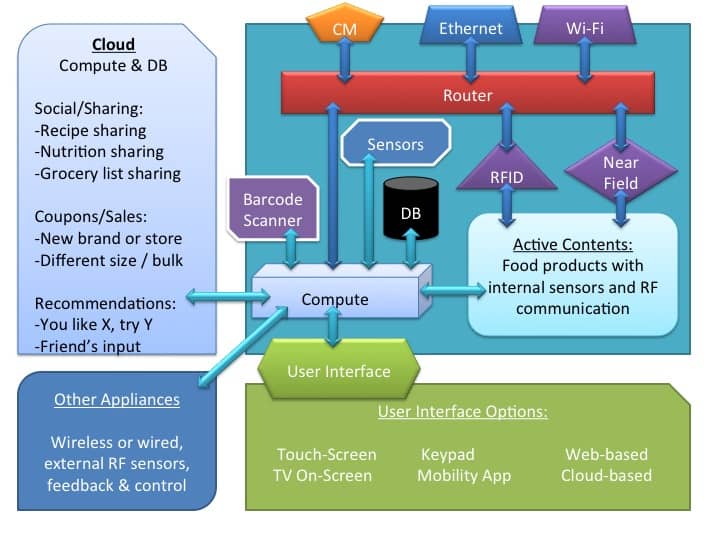The idea of a smart kitchen eco-system with a smart refrigerator at it’s core is one that I have been toying with for some time. I know that I’m not the first to think of it, at least abstractly, as it seems to be one of the first concepts to emerge when folks start to think about the practical applications of machine to machine (M2M) communication, the “Internet of Things,” Radio Frequency identification (RFID), and near field communications (NFC), etc. However, as of January 2012, I had not yet seen a practical description of how such a system would work and how it might generate revenue for those who would build it.
Note: LG introduced a Smart Refrigerator at this year’s CES that does include many of the features described below. Without the full smart kitchen system, it falls short of the full vision illustrated here though.
So when the topic came up at a lunch with some CableLabs co-workers (Joey Padden & Matthew D. Schmitt), I jumped at the opportunity to put my thoughts, and there’s, on paper. We booked a conference room and within an hour or so hashed out the broad strokes of a full smart-kitchen system, based on a core device which we dubbed the “eFridge.”
Our invention disclosure describes three things:
- A smart refrigerator (the eFridge) that acts as the hub of a full smart kitchen eco-system.
- A method for providing information to the eFridge via “smart” products and other means.
- A user interface for controlling the entire system, via the eFridge.
The smart kitchen system we describe solves the problems of keeping appropriate fresh food in constant supply, providing assistance with recipe creation and shopping list creation, kitchen inventory management, and nutritional assistance. It also brings social networking into the kitchen. It could also provide cost savings to the consumer by minimizing waste. This eFridge is an active and connected device that can be used as the hub of a smart kitchen, rather than just to keep things cool.
Features & Functions
The key pieces are the eFridge itself, the “Smart” food products, and other devices in the “Smart” appliance ecosystem. These products and devices will interact with each other in the following ways:
Ordering Process
- Individual food items can be equipped with sensors to detect how full they are. The items then signal their levels to the eFridge wirelessly. This could be done with RFID, Near Field, or some other communication protocol. Products not inside the eFridge can communicate with the eFridge via remote relays placed in cabinets, other refrigerators, a storage freezer, etc. These relays may communicate with the eFridge via Ethernet, Wi-Fi, or some other communication protocol.
- Food items not able to communicate directly with the eFridge can be scanned with a built in barcode/QR-Code scanner or entered into inventory manually through the User Interface.
- The eFridge keeps track of food levels, either locally, in the cloud, or some combination of both.
- The eFridge can be programmed to automatically order certain products when their levels cross a set threshold.
- The eFridge can be programmed to send a user alert (SMS, email, on-screen, audible, etc.) when certain products’ levels cross a set threshold.
- The eFridge can be programmed to generate a shopping list on demand, which considers current product levels, planned meals, or other criteria.
Expiration Management
- Individual food items with appropriate tagging information communicate their expiration date to the eFridge. For food items that are not appropriately tagged, the information can be entered by the user in many various ways.
- Individual food items could also be equipped with sensors to detect their freshness; this information is communicated to the eFridge.
- The eFridge can be equipped with internal sensors that can further monitor product levels, freshness, and other useful metrics.
- The eFridge tracks product expiration dates and freshness and can be programmed to auto-order, user-alert, etc. based on proximity to expiration date, freshness, and/or other means.
Recipe Interaction
- The eFridge is aware of all food on hand. The eFridge is Internet connected and can have support from a cloud based application. This allows the eFridge to provide suggested recipes based on food currently on hand.
- The eFridge can also provide recipe’s for which most of the ingredients are on hand but some need to be purchased. This would result in a shopping list or an auto order, and a recipe.
- The eFridge can reverse this process as well, in this case the customer selects a recipe or a list of recipes and the eFridge provides a shopping list (or auto-order) that will provide all of the needed ingredients (taking into account food already on hand).
- This process can be enhanced with a cloud based application that provides meal planning assistance, etc.
- The eFridge can also track leftovers in reusable “Smart” containers marked with a number of portions leftover from an eFridge provided recipe.
- The eFridge can suggest recipes based upon food nearing expiration to prevent food waste. This function can be combined with any of the above recipe functions.
Nutrition Tracking
- Because the eFridge is aware of all food products entering and leaving the kitchen, it can provide household level nutrition tracking.
- This nutrition tracking can be enhanced with dietary restrictions (not allowing the order of certain foods).
- The eFridge could potentially be tied into your health care provider to download restrictions and/or upload history.
Controlling the Smart Kitchen
In all of these cases, the eFridge could be equipped with one or more methods for customers to interact with it. Some examples include:
- Touch-screen: Built into the eFridge
- Keypad: Built into the eFridge
- Web-based: A web server built into the eFridge that allows it to be accessed from the local network and/or remotely from the Internet
- TV On-Screen: A tie-in to the customer’s set-top box (STB), game console, SmartTV, etc. allows on screen interaction with the eFridge
- Mobility Application: Access the eFridge from your smart phone or tablet
- Cloud-Based: A cloud based interface to allow remote access and perhaps access to advanced features
Any/all of these User Interfaces (UIs) would provide basic control of the eFridge and, through it, control of other smart appliances. Additionally, some or all of these UIs could provide access to advanced features, such as:
Social/Sharing
- Recipe sharing
- Nutrition sharing
- Grocery list sharing
This is inclusive of all posting (manual, pre-programmed, or automatic) to social media websites such as Facebook and Twitter, as well as a possible eFridge specific social media platform or forum.
Coupons/Sales
- The eFridge manufacturer, service provider, retailer or ISP/MSO can provide coupons and sale notifications directly to the customer
- Based on history; could offer alternative brands, retailers, sizes, etc.
Recommendations
“You liked X, try Y.” Recommendations can come from social media friends/contacts, or any of the folks listed above under coupons and sales, etc.
The Smart Kitchen Business Case
We have identified four potential business models that could be built around the eFridge:
An “Amazon Kindle” style model where a retailer provides the eFridge at a low cost as a way to ensure that customers order food products through the retailer. By providing an eFridge tied directly to their cloud based ordering system at or below cost, the retailer creates a captive audience of consumers.
The second model is one where multiple manufacturers offer the eFridge, along with a host of “Apps” that allow it to be tied into multiple retailors of the customer’s choice.
The third model would serve as an add-on to one of the above models in the form of a medical health and diet tracking service. There could be a way for doctors to push dietary restrictions down to customers or for customers to share their diet information directly with healthcare professionals.
Finally, commercial kitchens and businesses in the food services industry could simplify inventory management and reduce waste using an eFridge system. Restaurants, grocery stores, and food producers could use a “Just in Time” model facilitated by a more complete and automated food supply tracking system.
So What?
While nothing I have described here is likely to be earth-shattering or revolutionary to those who work and think in this space, I hope it provides a more concrete and comprehensive view of what the smart kitchen of the future could look like. This is beneficial for a few reasons:
Speed Deployment
Enabling this (or a similar) smart kitchen eco-system is all about simply doing it at this point. The technologies described here are all available today. Hopefully the details we provided in our disclosure will help folks see what is possible and begin demanding it and creating it sooner, rather than later.
Open the Design
Hopefully publishing the basic blueprints of this system publicly will also help ensure that when commercial smart kitchen systems are created, they are done so in an open manner. This is important to avoid product silos, vendor lock-in, and planned obsolescence. My hope is that this entire smart kitchen eco-system will grow up around open standards (both hardware and software) so that you can easily build and grow your own smart kitchen over time without having to worry about interoperability, etc.
Highlight IPv6
The best way to ensure that a smart kitchen (or smart garage, smart home, smart car, etc.) system like the one described here is open and interoperable is to base it on a standardized communications protocol. IPv6 is the protocol that can enable such a system. Therefor, publishing this idea may also help to provide an approachable real-world illustration of what we mean when we say M2M and Internet of Things. It is an idea that I think most folks can easily wrap their heads around and see value in. It clearly demonstrates the value of IPv6 adoption (having a nearly unlimited number of addresses allows any device to communicate with any other device, which is the foundation of this system and many others like it). This is of course just the tip of the iceberg when it comes to the next generation Internet protocol and what it will allow us to do. It is, however, a tip that I hope will help us to discuss, and to discover, the rest of the ice below the surface.
Fin
As always, I’d really love to hear your feedback. Is this old news? Am I off my rocker entirely?
What other “smart” systems can open communication via IPv6 enable?
What other applications are there for this basic structural model?
Where else will the Internet of Things take us?








I saw the lg fridge many years ago and thought they got some things right. Win 95 was a big mistake!! The scanning function should be attached to your trash bin. When you empty something you scan the item and it is removed from your kitchen inventory. The scanner probably needs to be portable to scan items in as you bring into the house from a shopping trip. The kitchen inventory needs some intelligence to be able to predict usage patterns so you dont run out of milk. No real need for all the item sensors if there is this intelligence.
I just wanted to say I had this very same idea and just found you in google.